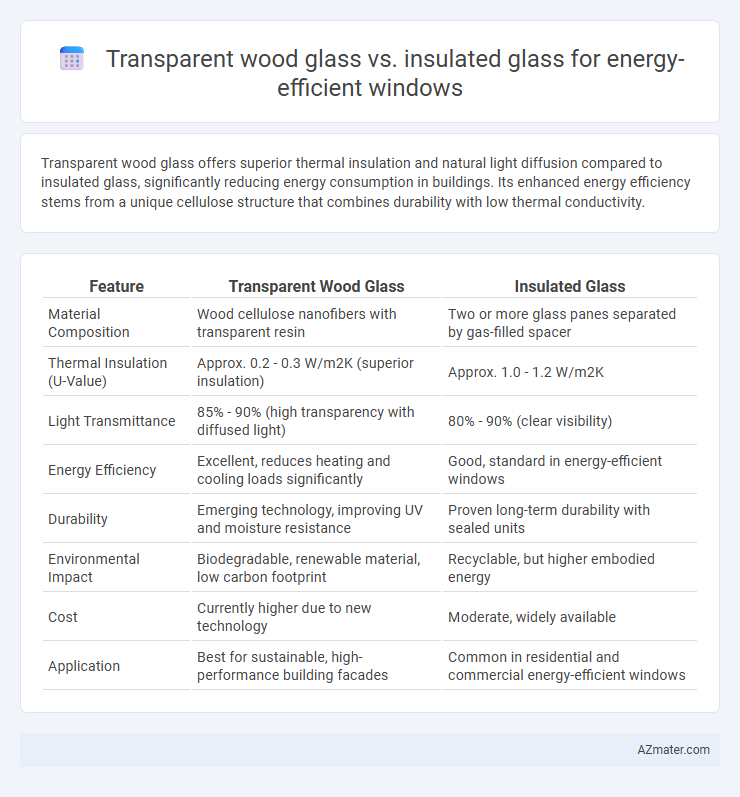Transparent wood glass offers superior thermal insulation and natural light diffusion compared to insulated glass, significantly reducing energy consumption in buildings. Its enhanced energy efficiency stems from a unique cellulose structure that combines durability with low thermal conductivity.
Table of Comparison
| Feature | Transparent Wood Glass | Insulated Glass |
|---|---|---|
| Material Composition | Wood cellulose nanofibers with transparent resin | Two or more glass panes separated by gas-filled spacer |
| Thermal Insulation (U-Value) | Approx. 0.2 - 0.3 W/m2K (superior insulation) | Approx. 1.0 - 1.2 W/m2K |
| Light Transmittance | 85% - 90% (high transparency with diffused light) | 80% - 90% (clear visibility) |
| Energy Efficiency | Excellent, reduces heating and cooling loads significantly | Good, standard in energy-efficient windows |
| Durability | Emerging technology, improving UV and moisture resistance | Proven long-term durability with sealed units |
| Environmental Impact | Biodegradable, renewable material, low carbon footprint | Recyclable, but higher embodied energy |
| Cost | Currently higher due to new technology | Moderate, widely available |
| Application | Best for sustainable, high-performance building facades | Common in residential and commercial energy-efficient windows |
Introduction to Energy-Efficient Window Technologies
Energy-efficient window technologies include transparent wood glass and insulated glass, both designed to reduce heat transfer and improve insulation. Transparent wood glass combines the natural translucency of modified wood with glass components, offering enhanced thermal performance and durability. Insulated glass units consist of two or more glass panes separated by an air or gas-filled space, providing superior energy retention and soundproofing.
What Is Transparent Wood Glass?
Transparent wood glass is an innovative building material produced by removing lignin from wood and filling the resulting porous structure with a transparent polymer, offering high strength and excellent optical clarity. This material boasts superior insulation properties compared to traditional insulated glass, reducing heat transfer and enhancing energy efficiency in windows. By combining natural wood's thermal insulation with transparency, transparent wood glass significantly minimizes energy consumption in buildings while maintaining daylight transmission.
Understanding Insulated Glass Units (IGUs)
Insulated Glass Units (IGUs) consist of two or more glass panes separated by a spacer filled with air or inert gas, significantly improving thermal performance by reducing heat transfer. Transparent wood glass, while innovative and eco-friendly, typically lacks the multi-pane structure and gas-filled cavity that make IGUs highly effective for energy efficiency in windows. The superior insulation of IGUs helps maintain indoor temperatures, reduces energy costs, and minimizes condensation compared to traditional or alternative glazing materials.
Thermal Insulation Performance Comparison
Transparent wood glass exhibits superior thermal insulation performance compared to traditional insulated glass, owing to its natural cellulose fibers that reduce heat transfer and enhance energy efficiency. Studies show that transparent wood can achieve thermal conductivity values as low as 0.1 W/m*K, significantly lower than the 1.0-3.0 W/m*K range typically seen in insulated glass units. This improved insulation capacity translates to better temperature regulation, lower heating and cooling costs, and increased sustainability in building applications.
Transparency and Light Transmission
Transparent wood glass offers superior natural light transmission due to its high transparency and low reflectance, improving interior brightness while maintaining thermal insulation. Insulated glass provides effective thermal performance through multiple glass panes and gas fills but can reduce light transmission because of additional layers and coatings. Choosing transparent wood glass enhances daylight exposure without compromising energy efficiency, making it ideal for energy-efficient windows prioritizing natural illumination.
Environmental Impact and Sustainability
Transparent wood glass offers superior environmental benefits compared to insulated glass due to its renewable raw materials and lower carbon footprint during production, as it utilizes cellulose from wood, a biodegradable and sustainable resource. Insulated glass, often composed of multiple glass layers and metal spacers, involves energy-intensive manufacturing and challenges in recycling, leading to higher environmental impact. Transparent wood glass enhances energy efficiency by providing excellent thermal insulation and reducing reliance on synthetic materials, making it a more sustainable choice for eco-friendly windows.
Durability and Longevity
Transparent wood glass exhibits superior durability due to its resistance to cracking and impact compared to conventional insulated glass, which can be prone to seal failure and moisture ingress over time. Its natural fibrous structure enhances longevity by maintaining structural integrity under varying environmental conditions, whereas insulated glass units often require replacement after 10-20 years due to gas leakage or seal degradation. This makes transparent wood glass a promising alternative for energy-efficient windows with extended lifespan and reduced maintenance needs.
Cost and Availability
Transparent wood glass offers innovative energy efficiency with moderate costs but remains limited in availability due to emerging technology and specialized manufacturing processes. Insulated glass, widely available and cost-effective, provides proven thermal performance through multiple glass panes and gas fills, making it a popular choice for energy-efficient windows. Cost considerations favor insulated glass for large-scale projects, while transparent wood glass may command premium pricing driven by niche market demand.
Architectural and Design Flexibility
Transparent wood glass offers superior architectural and design flexibility due to its lightweight nature and customizable translucency, enabling innovative light diffusion and aesthetic options. Insulated glass, while providing high thermal performance through multiple glazing layers, is limited by its rigidity and heavier weight, restricting design versatility. The adaptability of transparent wood glass allows integration into diverse architectural forms, enhancing energy efficiency without compromising creative design.
Future Trends in Energy-Efficient Window Materials
Transparent wood glass combines high strength and natural insulation properties with the aesthetic appeal of wood, offering superior thermal performance and reduced energy consumption compared to traditional insulated glass units (IGUs). Advanced coatings and nanomaterial integrations in insulated glass enhance solar control and thermal insulation, but transparent wood glass shows promise for deeper energy savings due to its low thermal conductivity and carbon sequestration potential. Future trends emphasize hybrid composites and smart glazing technologies that integrate transparent wood elements to optimize daylighting, durability, and climate-responsive energy efficiency in building envelopes.

Infographic: Transparent wood glass vs Insulated glass for Energy efficient window
 azmater.com
azmater.com